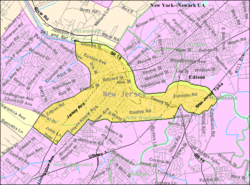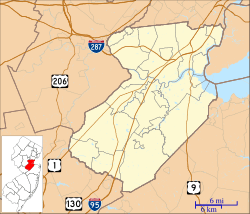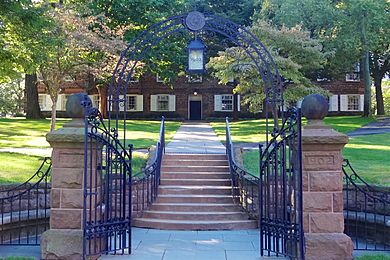Old Queens facts for kids
|
Old Queens
|
|

Old Queens, oldest building at Rutgers University
|
|
| Location | New Brunswick, New Jersey |
|---|---|
| Built | 1809–1825 |
| Architect | John McComb Jr. |
| Architectural style | Federal |
| NRHP reference No. | 76001164 |
Quick facts for kids Significant dates |
|
| Added to NRHP | May 11, 1976 |
| Designated NHL | May 11, 1976 |
Old Queens is the oldest building at Rutgers University. It is like the heart of the university's main campus in New Brunswick, New Jersey. Rutgers is one of the oldest colleges in the United States, started in 1766. Back then, it was called Queen's College. It was named after Charlotte of Mecklenburg-Strelitz, who was the queen of British king George III.
Old Queens sits on a six-acre block of land. This land used to be an apple orchard. It was given to the college in 1807. This area became known as the Queen's Campus. It is the historic center of the university. Because of this, people sometimes use "Old Queens" to mean Rutgers University itself.
The building was designed by John McComb Jr., who also designed New York City Hall. The first stone for Old Queens was placed in 1809. This was done by the college's third president, Ira Condict. Building took a long time because of money problems. It was finally finished in 1825.
In its early days, Old Queens was used for classes. It also had rooms for students and teachers. There was a library and a chapel. This chapel was shared by the college, its grammar school, and a seminary. Today, Old Queens holds the university's main offices. This includes the president's office.
Old Queens was added to the National Register of Historic Places in 1976. This means it is a very important historic site. It is a great example of Federal architecture. The whole Queen's Campus, including Old Queens, was added to the Register in 1973.
Contents
History of Old Queens
How Rutgers Began (1766–1808)
Queen's College started on November 10, 1766. It was a small, private college. It was connected to the Dutch Reformed church. The goal was to teach young people languages, arts, and sciences. It also prepared them for church work. It is the eighth-oldest college in the United States. It is one of nine "Colonial Colleges" started before the American Revolution.
The college was named for Charlotte of Mecklenburg-Strelitz. She was a German princess who became Queen of Britain. At first, classes were held in a tavern. It was called "The Sign of the Red Lion" in New Brunswick. Later, they moved to another building on George Street. Finally, in 1809, they started building Old Queens on a hill.
During the American Revolution, this hill was important. Alexander Hamilton placed his cannons there. He helped protect George Washington's soldiers. This was when they were retreating from the British in 1776. British forces chased Washington's army to New Brunswick.
The hill belonged to John Parker, a merchant. His family, including James Parker, Jr., gave the land to Queen's College in 1808. James Parker, Jr. later became a trustee of the college. The college had closed in 1795 because of money issues. It reopened in 1807 after a big fundraising effort. This effort was led by Ira Condict and John Henry Livingston. The money helped build a permanent home for the college. It also helped its grammar school and Livingston's seminary.
Building the College (1808-1825)
The college hired John McComb Jr. to design Old Queens. He was a famous architect from New York. He designed many important buildings. These include the Cape Henry Light and New York City Hall.
The first stone for Old Queens was placed on April 27, 1809. This was done by President Ira Condict. Abraham Blauvelt, a local newspaper publisher, watched over the building work. Some of the actual construction was done by enslaved people. One man named Will, who belonged to Dr. Jacob Dunham, worked on the building.
Today, Rutgers remembers Will's work. They have put up a sign honoring him. The brick path to the building is called "Will's Walk." This helps everyone remember that slavery was a part of life in New Brunswick.
The building took a long time to finish. This was because the college had money problems. It was not completed until 1825. But classes started in parts of the building as early as 1811. The seminary moved to a new campus in 1856. The grammar school moved across the street in 1830.
In 1825, Colonel Henry Rutgers helped the college. He was a hero from the American Revolutionary War. He gave the college $5,000 and a bell. The college was renamed Rutgers in his honor. The bell, called the Old Queens Bell, was placed in the tower. It rings to mark the end of classes. It is still there today. It rings for special events, like graduation.
How Old Queens is Used Today
At first, Old Queens held everything for the college. The first floor had classrooms. The second floor had the chapel and library. The parts on each side of the building were living areas for teachers. Students lived in boarding houses nearby.
Today, Old Queens holds the offices of the university president. It also has other top leaders. As Rutgers grew, Old Queens stayed the main building. It is often used to represent the university in media. This shows its importance in history and design.
Architecture of Old Queens
Old Queens is built from brownstone on the front and sides. The back is made of local field stone. Its design shows the "Federal style" of architecture. This style uses balance and classic shapes. It has columns and low triangle shapes like ancient Greek and Roman temples. The brownstone on the front is a very fancy style from New Jersey Dutch tradition.
Old Queens still has its original handmade glass windows. The windows on the lower floor are 12x8 panes. The second floor has 16x12 panes, and the third floor has 12x12 panes. There are round windows in the gables, which are common in Federal architecture.
A cupola (a small dome-like structure) was added in 1825. It has a weathervane on top. Inside is the Old Queens Bell, given by Colonel Henry Rutgers. The outside of the building looks almost exactly the same as when it was built. Students from long ago would still recognize it today.
Queen's Campus
Old Queens is the oldest building on the Queen's Campus. This campus is the historic center of the university. It has six old buildings. Old Queens itself is a special landmark. But the whole six-acre campus is also a historic site. It was added to the New Jersey Register of Historic Places in 1973. It was also added to the National Register of Historic Places in 1973.
The six buildings on Queen's Campus are:
- Old Queens (built 1809–1825)
- Van Nest Hall (1845)
- Daniel S. Schanck Observatory (1865)
- Geology Hall (1872)
- Kirkpatrick Chapel (1873)
- Winants Hall (1890)
There used to be a seventh building, the "President's House." It was built in 1841. But it was torn down in 1948 after a hurricane damaged it.
The Old Queens campus has four main entrances, called gateways. These include the Henry Rutgers Baldwin Gateway and the Class of 1902 Memorial Gateway. This last gate is special. Graduating students walk through it during their commencement ceremony in May.
In front of Old Queens is the Class of 1877 Cannon. This cannon reminds people of the Rutgers–Princeton Cannon War. It also honors students who served in the military. During graduation, students have a tradition. They break clay pipes over the cannon. This symbolizes leaving behind their childhood dreams and becoming adults.
Images for kids










